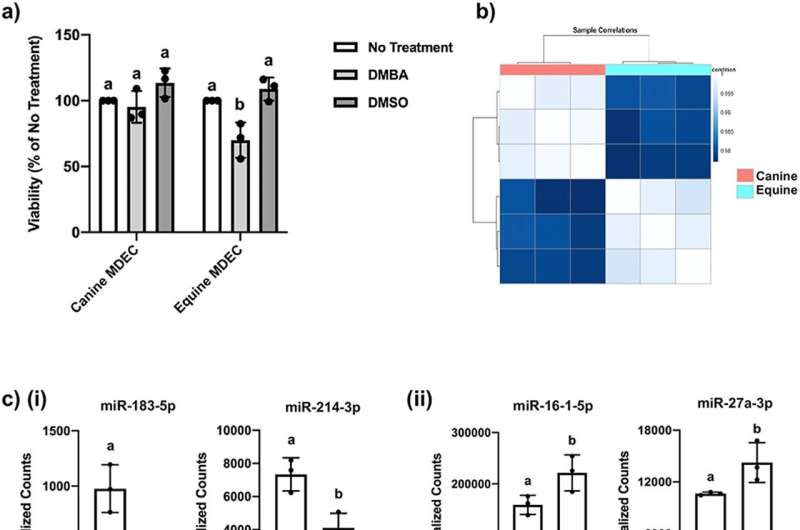This article has been reviewed according to Science X's editorial process and policies. Editors have highlighted the following attributes while ensuring the content's credibility:
fact-checked
peer-reviewed publication
trusted source
proofread
MicroRNA holds clues to why some mammals are cancer-prone

Researchers at the College of Veterinary Medicine (CVM) have identified an important pathway that reveals why some mammals, like humans, dogs, and cats, regularly develop mammary cancer while others, such as horses, pigs, and cows, rarely do.
They used an unusual approach to uncover a piece of that puzzle—why cells in some species become cancerous—which they described in a paper published in Communications Biology in October.
The discovery hinges on a previous finding that gives clues about the molecular mechanisms at play. Mammary stem cells from some species with low incidences of mammary cancer use a process called apoptosis to destroy cells with damaged DNA. In contrast, many species with a high incidence of mammary cancer repair their DNA-damaged cells, leaving them susceptible to potential cancerous mutations.
In the study, researchers focused on the role of microRNA-214-3p, a microRNA that is known to play a role in regulating apoptosis or cell destruction. They compared how microRNA-214-3p functions in stem cells from horses, which rarely develop mammary cancer, and from dogs, which regularly do. They discovered that microRNA-214-3p is expressed at low levels in horse cells but at higher levels in dog cells and that this low microRNA-214-3p expression promotes the apoptosis that destroys horse cells with damaged DNA.
"Our research is novel because we worked with healthy cells, not cancer cells, trying to understand how a microRNA can prevent cells from becoming cancerous," said Rebecca Harman, the study's lead author and a research support specialist at the Baker Institute for Animal Health. "There are still many details to be worked out. This is a small piece of the puzzle, but it's an important piece."
Harman works in the laboratory of Dr. Gerlinde Van de Walle, the Alfred H. Caspary Professor and interim director of the Baker Institute for Animal Health. They collaborated closely with Praveen Sethupathy, professor of physiological genomics and chair of the Department of Biomedical Sciences at CVM, who studies the role of microRNAs in animal and human diseases, including cancer.
"MicroRNAs are generally understudied in veterinary cancers," Sethupathy said. "This work represents and builds on the emphasis on comparative cancer biology at Cornell."
After their initial findings, the research team conducted a second experiment to artificially increase the expression of miRNA-214-3p in horse cells. This led to the inhibition of apoptosis: When miRNA-214-3p expression increased, DNA-damaged horse cells were less likely to be destroyed.
Conducting similar experimental approaches in multiple species is another valuable aspect of this research, Van de Walle said.
"The most exciting part of this kind of research is comparing species who get the disease to those that don't," she said. "With this comparative approach, you can find new information that you would miss from looking at only one species. And we are more likely to be able to apply our findings to human disease."
More information: Rebecca M. Harman et al, miRNA-214-3p stimulates carcinogen-induced mammary epithelial cell apoptosis in mammary cancer-resistant species, Communications Biology (2023). DOI: 10.1038/s42003-023-05370-4
Journal information: Communications Biology
Provided by Cornell University



















